Jihyung Kil
CompBench: A Comparative Reasoning Benchmark for Multimodal LLMs
Jul 23, 2024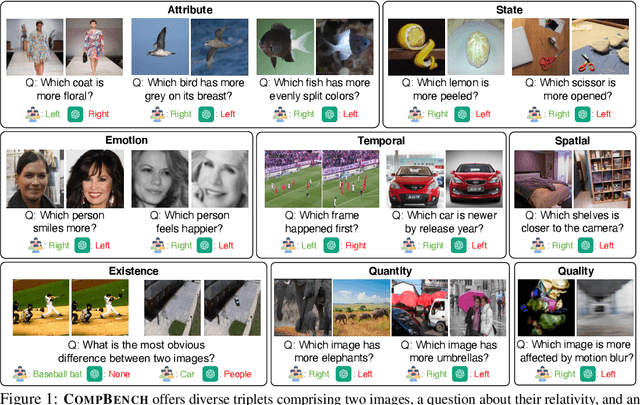
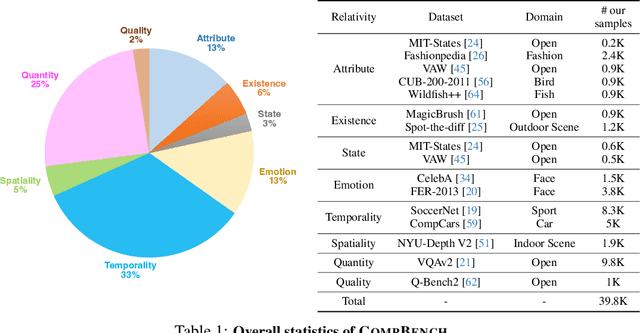
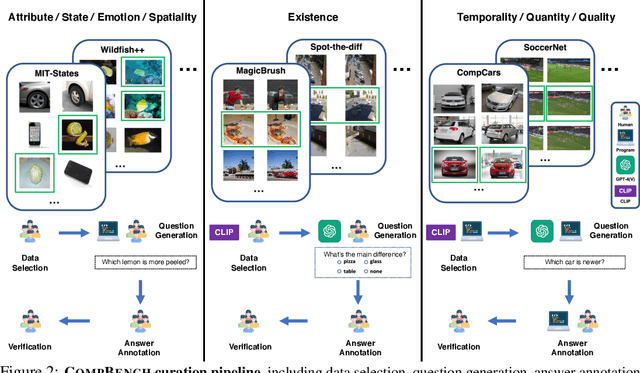
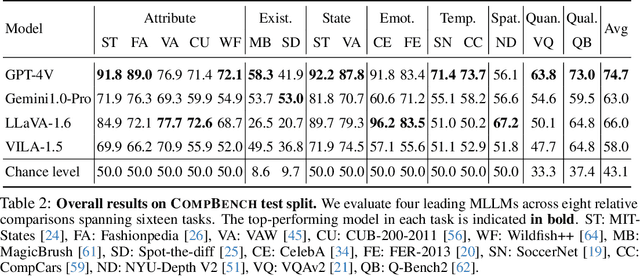
Abstract:The ability to compare objects, scenes, or situations is crucial for effective decision-making and problem-solving in everyday life. For instance, comparing the freshness of apples enables better choices during grocery shopping, while comparing sofa designs helps optimize the aesthetics of our living space. Despite its significance, the comparative capability is largely unexplored in artificial general intelligence (AGI). In this paper, we introduce CompBench, a benchmark designed to evaluate the comparative reasoning capability of multimodal large language models (MLLMs). CompBench mines and pairs images through visually oriented questions covering eight dimensions of relative comparison: visual attribute, existence, state, emotion, temporality, spatiality, quantity, and quality. We curate a collection of around 40K image pairs using metadata from diverse vision datasets and CLIP similarity scores. These image pairs span a broad array of visual domains, including animals, fashion, sports, and both outdoor and indoor scenes. The questions are carefully crafted to discern relative characteristics between two images and are labeled by human annotators for accuracy and relevance. We use CompBench to evaluate recent MLLMs, including GPT-4V(ision), Gemini-Pro, and LLaVA-1.6. Our results reveal notable shortcomings in their comparative abilities. We believe CompBench not only sheds light on these limitations but also establishes a solid foundation for future enhancements in the comparative capability of MLLMs.
ARES: Alternating Reinforcement Learning and Supervised Fine-Tuning for Enhanced Multi-Modal Chain-of-Thought Reasoning Through Diverse AI Feedback
Jun 25, 2024Abstract:Large Multimodal Models (LMMs) excel at comprehending human instructions and demonstrate remarkable results across a broad spectrum of tasks. Reinforcement Learning from Human Feedback (RLHF) and AI Feedback (RLAIF) further refine LLMs by aligning them with specific preferences. These methods primarily use ranking-based feedback for entire generations. With advanced AI models (Teacher), such as GPT-4 and Claude 3 Opus, we can request various types of detailed feedback that are expensive for humans to provide. We propose a two-stage algorithm ARES that Alternates REinforcement Learning (RL) and Supervised Fine-Tuning (SFT). First, we request the Teacher to score how much each sentence contributes to solving the problem in a Chain-of-Thought (CoT). This sentence-level feedback allows us to consider individual valuable segments, providing more granular rewards for the RL procedure. Second, we ask the Teacher to correct the wrong reasoning after the RL stage. The RL procedure requires massive efforts for hyperparameter tuning and often generates errors like repetitive words and incomplete sentences. With the correction feedback, we stabilize the RL fine-tuned model through SFT. We conduct experiments on multi-model dataset ScienceQA and A-OKVQA to demonstrate the effectiveness of our proposal. ARES rationale reasoning achieves around 70% win rate against baseline models judged by GPT-4o. Additionally, we observe that the improved rationale reasoning leads to a 2.5% increase in inference answer accuracy on average for the multi-modal datasets.
II-MMR: Identifying and Improving Multi-modal Multi-hop Reasoning in Visual Question Answering
Feb 16, 2024



Abstract:Visual Question Answering (VQA) often involves diverse reasoning scenarios across Vision and Language (V&L). Most prior VQA studies, however, have merely focused on assessing the model's overall accuracy without evaluating it on different reasoning cases. Furthermore, some recent works observe that conventional Chain-of-Thought (CoT) prompting fails to generate effective reasoning for VQA, especially for complex scenarios requiring multi-hop reasoning. In this paper, we propose II-MMR, a novel idea to identify and improve multi-modal multi-hop reasoning in VQA. In specific, II-MMR takes a VQA question with an image and finds a reasoning path to reach its answer using two novel language promptings: (i) answer prediction-guided CoT prompt, or (ii) knowledge triplet-guided prompt. II-MMR then analyzes this path to identify different reasoning cases in current VQA benchmarks by estimating how many hops and what types (i.e., visual or beyond-visual) of reasoning are required to answer the question. On popular benchmarks including GQA and A-OKVQA, II-MMR observes that most of their VQA questions are easy to answer, simply demanding "single-hop" reasoning, whereas only a few questions require "multi-hop" reasoning. Moreover, while the recent V&L model struggles with such complex multi-hop reasoning questions even using the traditional CoT method, II-MMR shows its effectiveness across all reasoning cases in both zero-shot and fine-tuning settings.
Dual-View Visual Contextualization for Web Navigation
Feb 06, 2024



Abstract:Automatic web navigation aims to build a web agent that can follow language instructions to execute complex and diverse tasks on real-world websites. Existing work primarily takes HTML documents as input, which define the contents and action spaces (i.e., actionable elements and operations) of webpages. Nevertheless, HTML documents may not provide a clear task-related context for each element, making it hard to select the right (sequence of) actions. In this paper, we propose to contextualize HTML elements through their "dual views" in webpage screenshots: each HTML element has its corresponding bounding box and visual content in the screenshot. We build upon the insight -- web developers tend to arrange task-related elements nearby on webpages to enhance user experiences -- and propose to contextualize each element with its neighbor elements, using both textual and visual features. The resulting representations of HTML elements are more informative for the agent to take action. We validate our method on the recently released Mind2Web dataset, which features diverse navigation domains and tasks on real-world websites. Our method consistently outperforms the baseline in all the scenarios, including cross-task, cross-website, and cross-domain ones.
GPT-4V is a Generalist Web Agent, if Grounded
Jan 03, 2024Abstract:The recent development on large multimodal models (LMMs), especially GPT-4V(ision) and Gemini, has been quickly expanding the capability boundaries of multimodal models beyond traditional tasks like image captioning and visual question answering. In this work, we explore the potential of LMMs like GPT-4V as a generalist web agent that can follow natural language instructions to complete tasks on any given website. We propose SEEACT, a generalist web agent that harnesses the power of LMMs for integrated visual understanding and acting on the web. We evaluate on the recent MIND2WEB benchmark. In addition to standard offline evaluation on cached websites, we enable a new online evaluation setting by developing a tool that allows running web agents on live websites. We show that GPT-4V presents a great potential for web agents - it can successfully complete 50% of the tasks on live websites if we manually ground its textual plans into actions on the websites. This substantially outperforms text-only LLMs like GPT-4 or smaller models (FLAN-T5 and BLIP-2) specifically fine-tuned for web agents. However, grounding still remains a major challenge. Existing LMM grounding strategies like set-of-mark prompting turns out not effective for web agents, and the best grounding strategy we develop in this paper leverages both the HTML text and visuals. Yet, there is still a substantial gap with oracle grounding, leaving ample room for further improvement.
PreSTU: Pre-Training for Scene-Text Understanding
Sep 12, 2022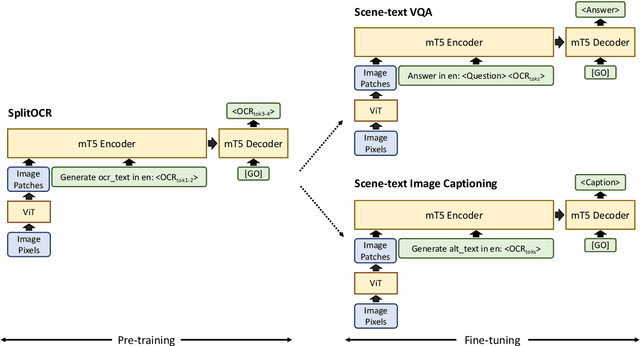

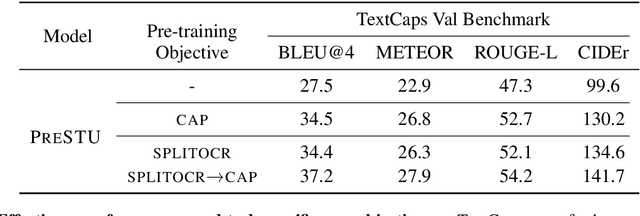
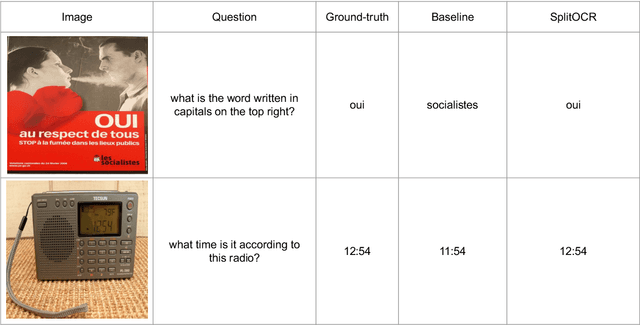
Abstract:The ability to read and reason about texts in an image is often lacking in vision-and-language (V&L) models. How can we learn V&L models that exhibit strong scene-text understanding (STU)? In this paper, we propose PreSTU, a simple pre-training recipe specifically designed for scene-text understanding. PreSTU combines a simple OCR-aware pre-training objective with a large-scale image-text dataset with off-the-shelf OCR signals. We empirically demonstrate the superiority of this pre-training objective on TextVQA, TextCaps, ST-VQA, and VizWiz-VQA. We also study which factors affect STU performance, where we highlight the importance of image resolution and dataset scale during pre-training.
One Step at a Time: Long-Horizon Vision-and-Language Navigation with Milestones
Feb 14, 2022



Abstract:We study the problem of developing autonomous agents that can follow human instructions to infer and perform a sequence of actions to complete the underlying task. Significant progress has been made in recent years, especially for tasks with short horizons. However, when it comes to long-horizon tasks with extended sequences of actions, an agent can easily ignore some instructions or get stuck in the middle of the long instructions and eventually fail the task. To address this challenge, we propose a model-agnostic milestone-based task tracker (M-TRACK) to guide the agent and monitor its progress. Specifically, we propose a milestone builder that tags the instructions with navigation and interaction milestones which the agent needs to complete step by step, and a milestone checker that systemically checks the agent's progress in its current milestone and determines when to proceed to the next. On the challenging ALFRED dataset, our M-TRACK leads to a notable 45% and 70% relative improvement in unseen success rate over two competitive base models.
Discovering the Unknown Knowns: Turning Implicit Knowledge in the Dataset into Explicit Training Examples for Visual Question Answering
Sep 13, 2021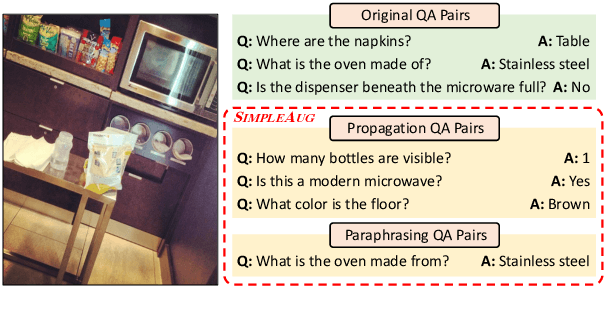

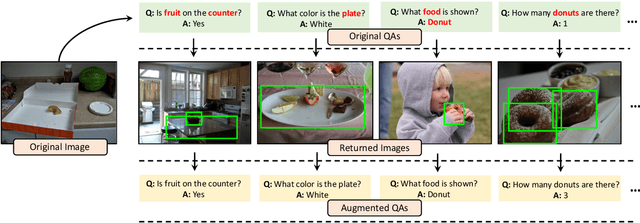
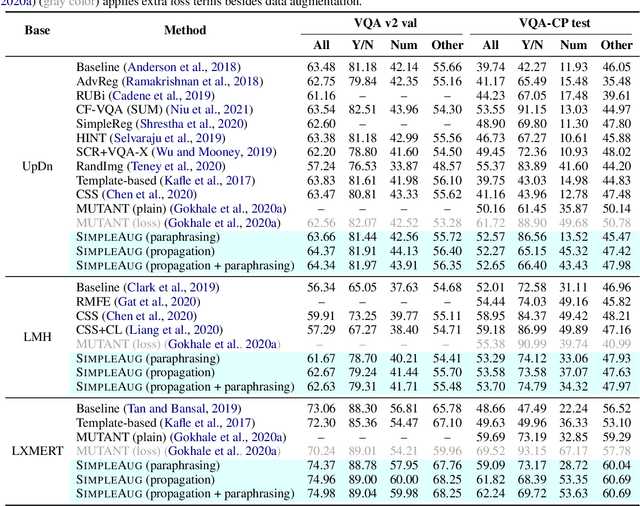
Abstract:Visual question answering (VQA) is challenging not only because the model has to handle multi-modal information, but also because it is just so hard to collect sufficient training examples -- there are too many questions one can ask about an image. As a result, a VQA model trained solely on human-annotated examples could easily over-fit specific question styles or image contents that are being asked, leaving the model largely ignorant about the sheer diversity of questions. Existing methods address this issue primarily by introducing an auxiliary task such as visual grounding, cycle consistency, or debiasing. In this paper, we take a drastically different approach. We found that many of the "unknowns" to the learned VQA model are indeed "known" in the dataset implicitly. For instance, questions asking about the same object in different images are likely paraphrases; the number of detected or annotated objects in an image already provides the answer to the "how many" question, even if the question has not been annotated for that image. Building upon these insights, we present a simple data augmentation pipeline SimpleAug to turn this "known" knowledge into training examples for VQA. We show that these augmented examples can notably improve the learned VQA models' performance, not only on the VQA-CP dataset with language prior shifts but also on the VQA v2 dataset without such shifts. Our method further opens up the door to leverage weakly-labeled or unlabeled images in a principled way to enhance VQA models. Our code and data are publicly available at https://github.com/heendung/simpleAUG.
Revisiting Document Representations for Large-Scale Zero-Shot Learning
Apr 21, 2021



Abstract:Zero-shot learning aims to recognize unseen objects using their semantic representations. Most existing works use visual attributes labeled by humans, not suitable for large-scale applications. In this paper, we revisit the use of documents as semantic representations. We argue that documents like Wikipedia pages contain rich visual information, which however can easily be buried by the vast amount of non-visual sentences. To address this issue, we propose a semi-automatic mechanism for visual sentence extraction that leverages the document section headers and the clustering structure of visual sentences. The extracted visual sentences, after a novel weighting scheme to distinguish similar classes, essentially form semantic representations like visual attributes but need much less human effort. On the ImageNet dataset with over 10,000 unseen classes, our representations lead to a 64% relative improvement against the commonly used ones.
 Add to Chrome
Add to Chrome Add to Firefox
Add to Firefox Add to Edge
Add to Edge